2001 FORD F750 engine coolant
[x] Cancel search: engine coolantPage 165 of 240
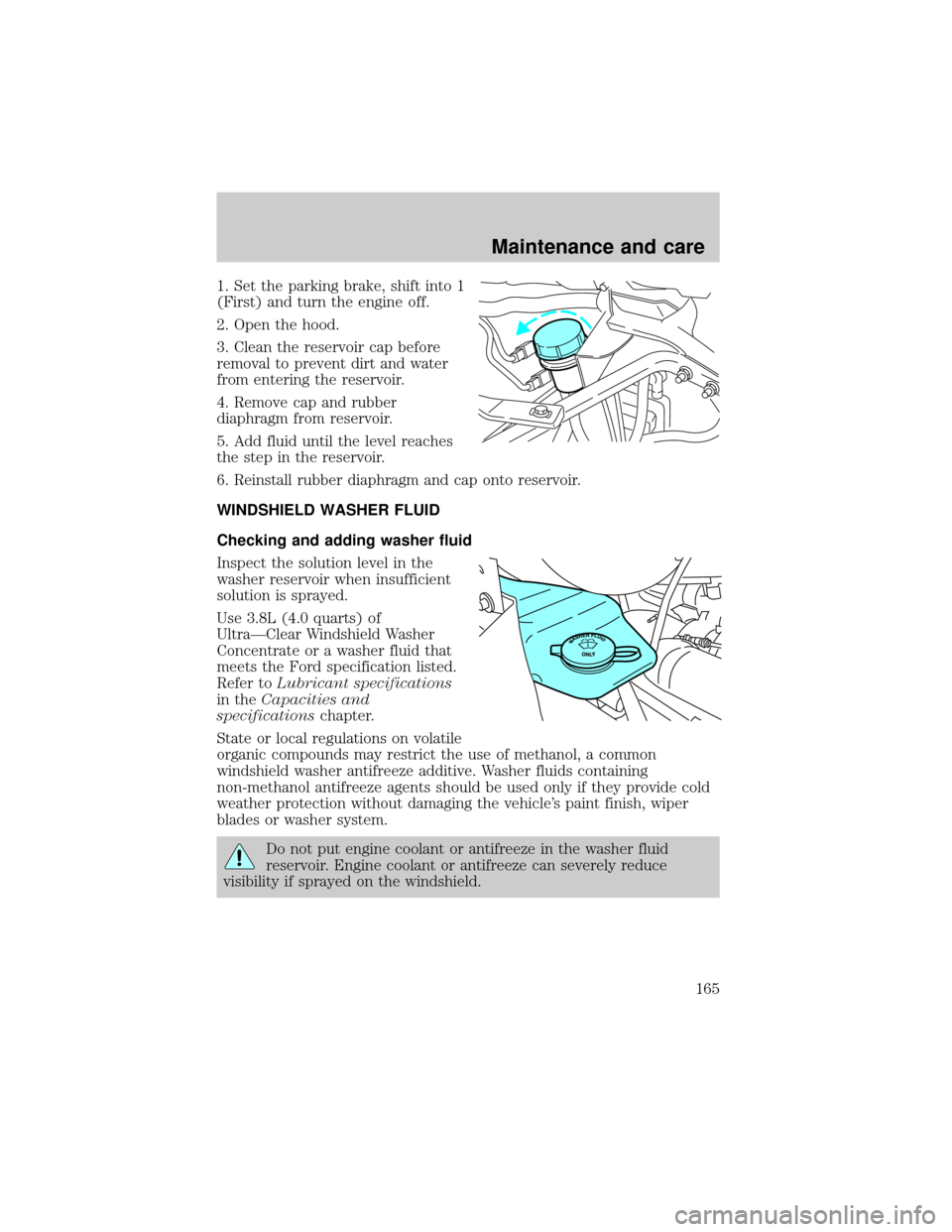
1. Set the parking brake, shift into 1
(First) and turn the engine off.
2. Open the hood.
3. Clean the reservoir cap before
removal to prevent dirt and water
from entering the reservoir.
4. Remove cap and rubber
diaphragm from reservoir.
5. Add fluid until the level reaches
the step in the reservoir.
6. Reinstall rubber diaphragm and cap onto reservoir.
WINDSHIELD WASHER FLUID
Checking and adding washer fluid
Inspect the solution level in the
washer reservoir when insufficient
solution is sprayed.
Use 3.8L (4.0 quarts) of
UltraÐClear Windshield Washer
Concentrate or a washer fluid that
meets the Ford specification listed.
Refer toLubricant specifications
in theCapacities and
specificationschapter.
State or local regulations on volatile
organic compounds may restrict the use of methanol, a common
windshield washer antifreeze additive. Washer fluids containing
non-methanol antifreeze agents should be used only if they provide cold
weather protection without damaging the vehicle's paint finish, wiper
blades or washer system.
Do not put engine coolant or antifreeze in the washer fluid
reservoir. Engine coolant or antifreeze can severely reduce
visibility if sprayed on the windshield.
Maintenance and care
165
Page 166 of 240
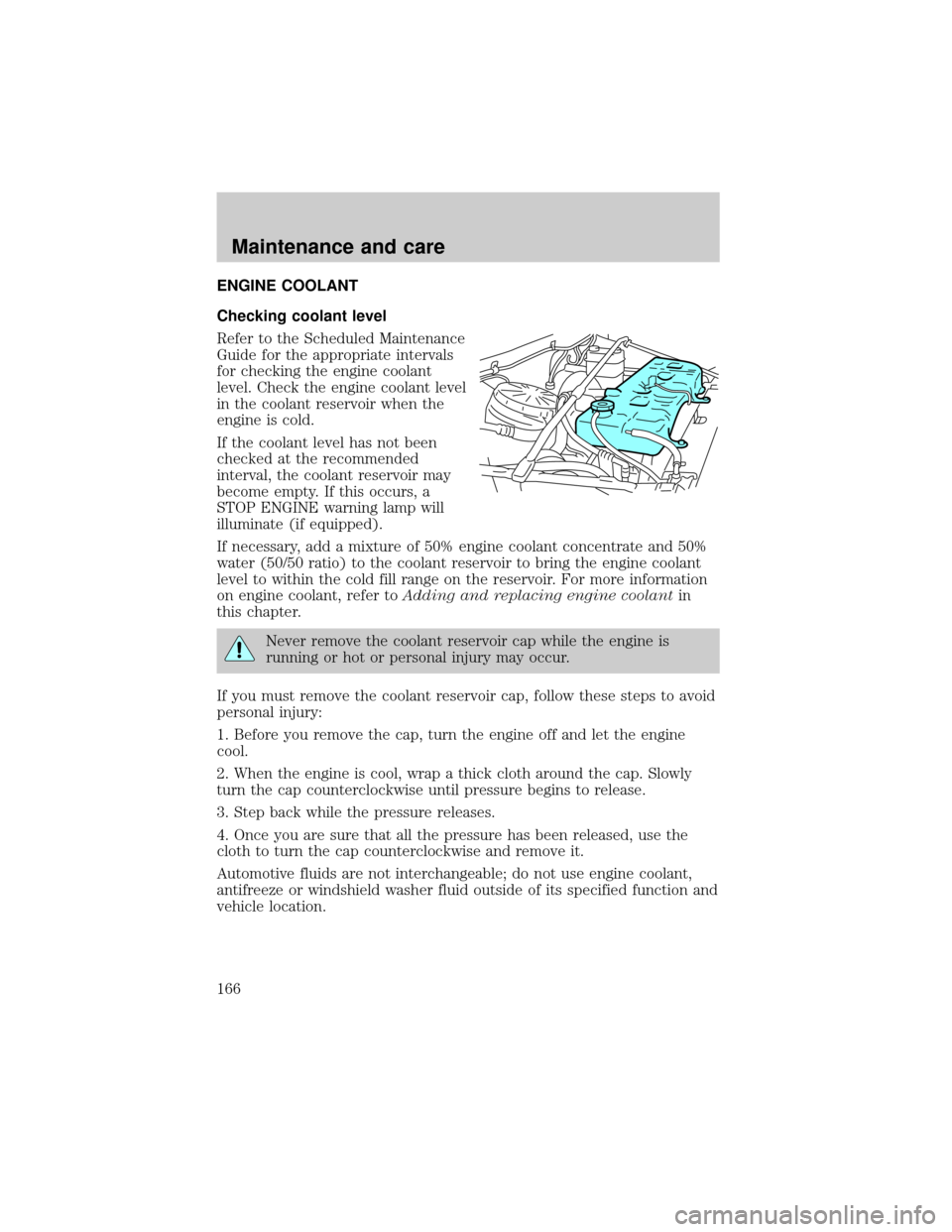
ENGINE COOLANT
Checking coolant level
Refer to the Scheduled Maintenance
Guide for the appropriate intervals
for checking the engine coolant
level. Check the engine coolant level
in the coolant reservoir when the
engine is cold.
If the coolant level has not been
checked at the recommended
interval, the coolant reservoir may
become empty. If this occurs, a
STOP ENGINE warning lamp will
illuminate (if equipped).
If necessary, add a mixture of 50% engine coolant concentrate and 50%
water (50/50 ratio) to the coolant reservoir to bring the engine coolant
level to within the cold fill range on the reservoir. For more information
on engine coolant, refer toAdding and replacing engine coolantin
this chapter.
Never remove the coolant reservoir cap while the engine is
running or hot or personal injury may occur.
If you must remove the coolant reservoir cap, follow these steps to avoid
personal injury:
1. Before you remove the cap, turn the engine off and let the engine
cool.
2. When the engine is cool, wrap a thick cloth around the cap. Slowly
turn the cap counterclockwise until pressure begins to release.
3. Step back while the pressure releases.
4. Once you are sure that all the pressure has been released, use the
cloth to turn the cap counterclockwise and remove it.
Automotive fluids are not interchangeable; do not use engine coolant,
antifreeze or windshield washer fluid outside of its specified function and
vehicle location.
Maintenance and care
166
Page 167 of 240
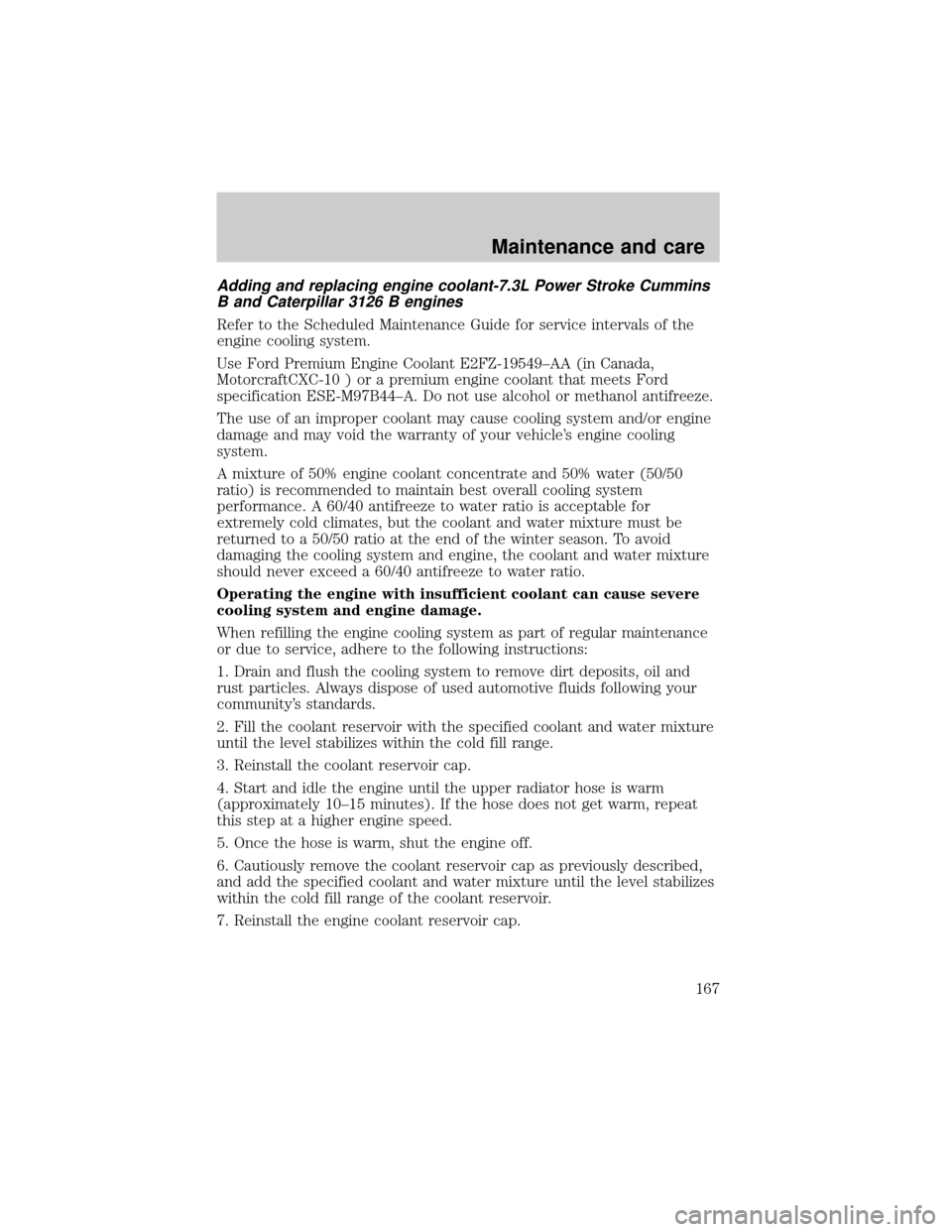
Adding and replacing engine coolant-7.3L Power Stroke Cummins
B and Caterpillar 3126 B engines
Refer to the Scheduled Maintenance Guide for service intervals of the
engine cooling system.
Use Ford Premium Engine Coolant E2FZ-19549±AA (in Canada,
MotorcraftCXC-10 ) or a premium engine coolant that meets Ford
specification ESE-M97B44±A. Do not use alcohol or methanol antifreeze.
The use of an improper coolant may cause cooling system and/or engine
damage and may void the warranty of your vehicle's engine cooling
system.
A mixture of 50% engine coolant concentrate and 50% water (50/50
ratio) is recommended to maintain best overall cooling system
performance. A 60/40 antifreeze to water ratio is acceptable for
extremely cold climates, but the coolant and water mixture must be
returned to a 50/50 ratio at the end of the winter season. To avoid
damaging the cooling system and engine, the coolant and water mixture
should never exceed a 60/40 antifreeze to water ratio.
Operating the engine with insufficient coolant can cause severe
cooling system and engine damage.
When refilling the engine cooling system as part of regular maintenance
or due to service, adhere to the following instructions:
1. Drain and flush the cooling system to remove dirt deposits, oil and
rust particles. Always dispose of used automotive fluids following your
community's standards.
2. Fill the coolant reservoir with the specified coolant and water mixture
until the level stabilizes within the cold fill range.
3. Reinstall the coolant reservoir cap.
4. Start and idle the engine until the upper radiator hose is warm
(approximately 10±15 minutes). If the hose does not get warm, repeat
this step at a higher engine speed.
5. Once the hose is warm, shut the engine off.
6. Cautiously remove the coolant reservoir cap as previously described,
and add the specified coolant and water mixture until the level stabilizes
within the cold fill range of the coolant reservoir.
7. Reinstall the engine coolant reservoir cap.
Maintenance and care
167
Page 168 of 240

Adding and replacing engine coolant-Caterpillar 3126 B engine
Refer to the engine operator's manual for additional engine cooling
system information.
FAN CLUTCHES
Your vehicle's cooling system is equipped with a viscous variable speed
fan clutch.
²The fan clutch helps control cooling, increase performance, improve
fuel economy and reduce noise.
²The fan clutch is controlled by bimetallic spring sensors. Do not
tamper with these sensors as this may change their calibration or keep
the fan clutch from operating at all.
Stay clear of the fan/fan area while the engine is running or
possible personal injury may occur.
CHECKING AND ADDING POWER STEERING FLUID
Checking power steering fluid level
Check the power steering fluid level using the following procedure. Refer
to the scheduled maintenance guide for the recommended service
intervals. If adding fluid is necessary, use only MERCONtAT F.
1. Set the parking brake, shift into N
(Neutral) (automatic transmission)
or 1 (First) (manual transmission)
and turn the engine off.
2. Open the hood.
3. Clean the top of the power
steering fluid reservoir.
4. Remove the dipstick from the
reservoir and wipe the dipstick clean.
Maintenance and care
168
Page 200 of 240
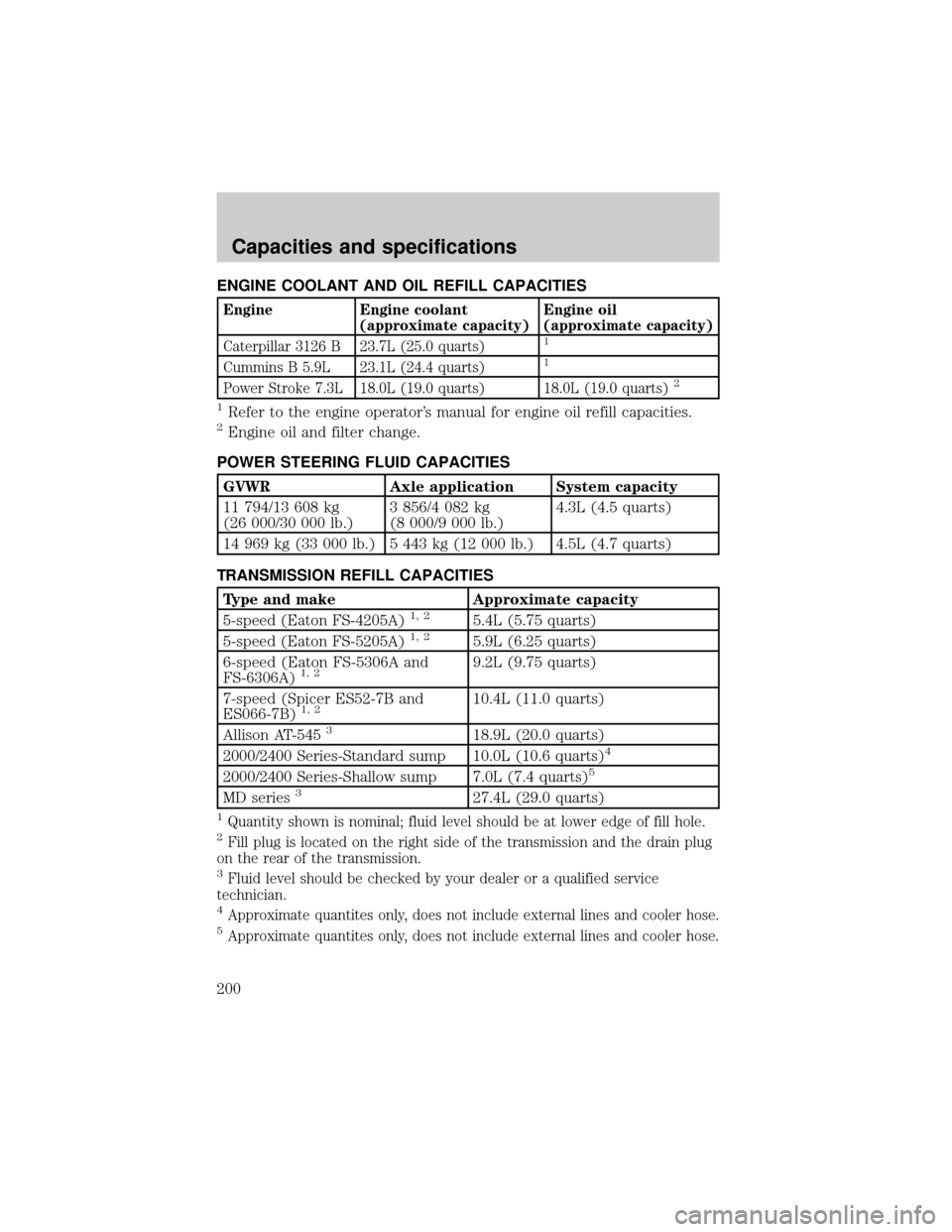
ENGINE COOLANT AND OIL REFILL CAPACITIES
Engine Engine coolant
(approximate capacity)Engine oil
(approximate capacity)
Caterpillar 3126 B 23.7L (25.0 quarts)
1
Cummins B 5.9L 23.1L (24.4 quarts)1
Power Stroke 7.3L 18.0L (19.0 quarts) 18.0L (19.0 quarts)2
1Refer to the engine operator's manual for engine oil refill capacities.2Engine oil and filter change.
POWER STEERING FLUID CAPACITIES
GVWR Axle application System capacity
11 794/13 608 kg
(26 000/30 000 lb.)3 856/4 082 kg
(8 000/9 000 lb.)4.3L (4.5 quarts)
14 969 kg (33 000 lb.) 5 443 kg (12 000 lb.) 4.5L (4.7 quarts)
TRANSMISSION REFILL CAPACITIES
Type and make Approximate capacity
5-speed (Eaton FS-4205A)1, 25.4L (5.75 quarts)
5-speed (Eaton FS-5205A)1, 25.9L (6.25 quarts)
6-speed (Eaton FS-5306A and
FS-6306A)
1, 29.2L (9.75 quarts)
7-speed (Spicer ES52-7B and
ES066-7B)
1, 210.4L (11.0 quarts)
Allison AT-545
318.9L (20.0 quarts)
2000/2400 Series-Standard sump 10.0L (10.6 quarts)4
2000/2400 Series-Shallow sump 7.0L (7.4 quarts)5
MD series327.4L (29.0 quarts)
1Quantity shown is nominal; fluid level should be at lower edge of fill hole.2Fill plug is located on the right side of the transmission and the drain plug
on the rear of the transmission.
3Fluid level should be checked by your dealer or a qualified service
technician.
4Approximate quantites only, does not include external lines and cooler hose.5Approximate quantites only, does not include external lines and cooler hose.
Capacities and specifications
200
Page 204 of 240
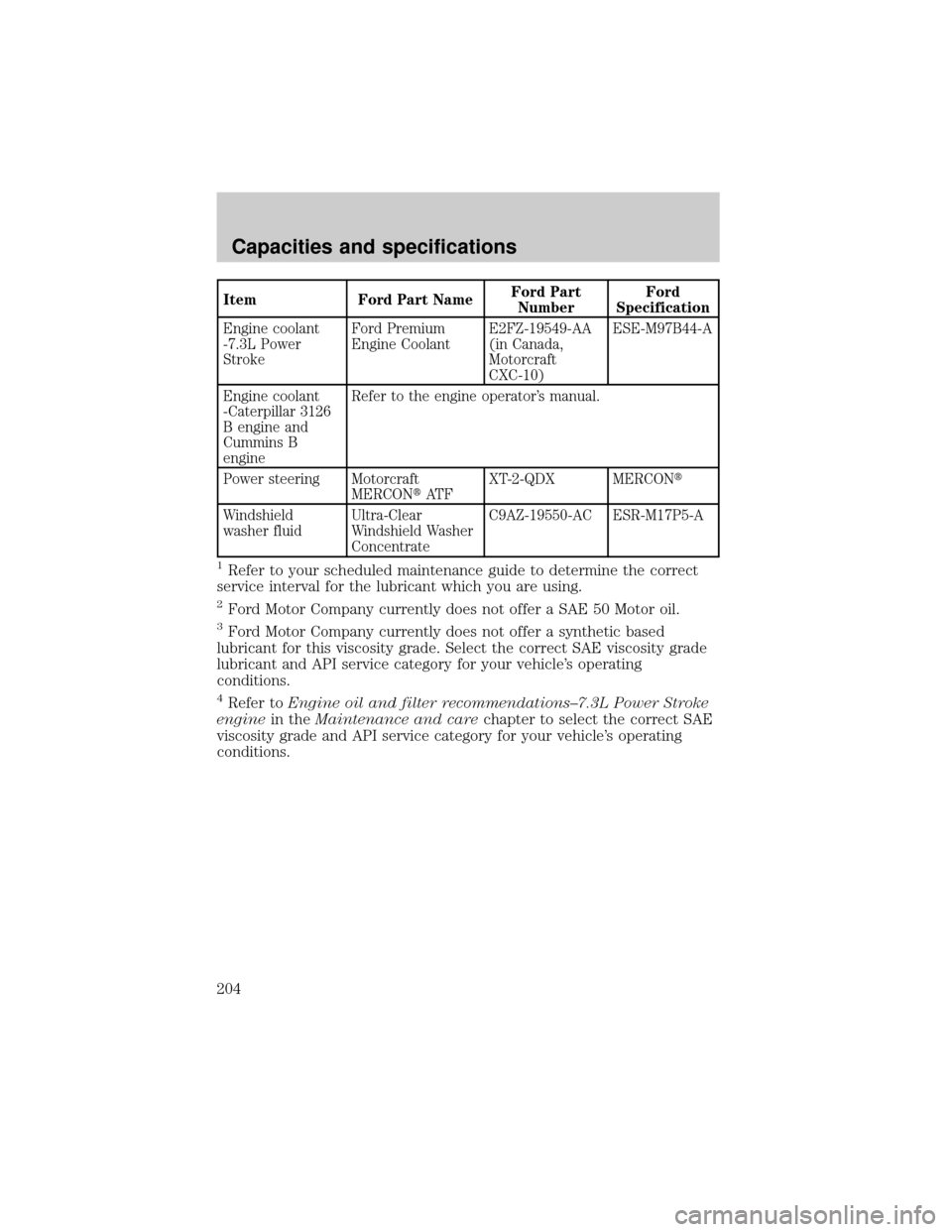
Item Ford Part NameFord Part
NumberFord
Specification
Engine coolant
-7.3L Power
StrokeFord Premium
Engine CoolantE2FZ-19549-AA
(in Canada,
Motorcraft
CXC-10)ESE-M97B44-A
Engine coolant
-Caterpillar 3126
B engine and
Cummins B
engineRefer to the engine operator's manual.
Power steering Motorcraft
MERCONtAT FXT-2-QDX MERCONt
Windshield
washer fluidUltra-Clear
Windshield Washer
ConcentrateC9AZ-19550-AC ESR-M17P5-A
1Refer to your scheduled maintenance guide to determine the correct
service interval for the lubricant which you are using.
2Ford Motor Company currently does not offer a SAE 50 Motor oil.
3Ford Motor Company currently does not offer a synthetic based
lubricant for this viscosity grade. Select the correct SAE viscosity grade
lubricant and API service category for your vehicle's operating
conditions.
4Refer toEngine oil and filter recommendations±7.3L Power Stroke
enginein theMaintenance and carechapter to select the correct SAE
viscosity grade and API service category for your vehicle's operating
conditions.
Capacities and specifications
204
Page 214 of 240

Daily Owner Checks Engine system
Check the air filter restriction indicator
Check the engine oil
Inspect the coolant level - for Powerstroke
engine (for Caterpillar and Cummins engines,
refer to the Owner's Manual)
Brake system
Drain the air brake system reservoir - manual
valve
Check the air brake system reservoir
automatic drain valve operation
Transmission system
Visually check the automatic transmission for
fluid leakage
Steering system
Check the power steering pump fluid level and
check the system for leaks
Check the entire vehicle for evidence of fluid
leaks
U.S. Department of Transportation,
Federal Highway Administration
requirements (ensure that the entire
system is functioning properly)
Check the service brakes
Check the parking brake
Check the steering mechanism
Check the lighting devices and reflectors
Check the tires
Check the horn
Check the windshield wipers
Check the rear vision mirrors
Check the wheels and rims
Check the emergency equipment
General maintenance information
214
Page 216 of 240
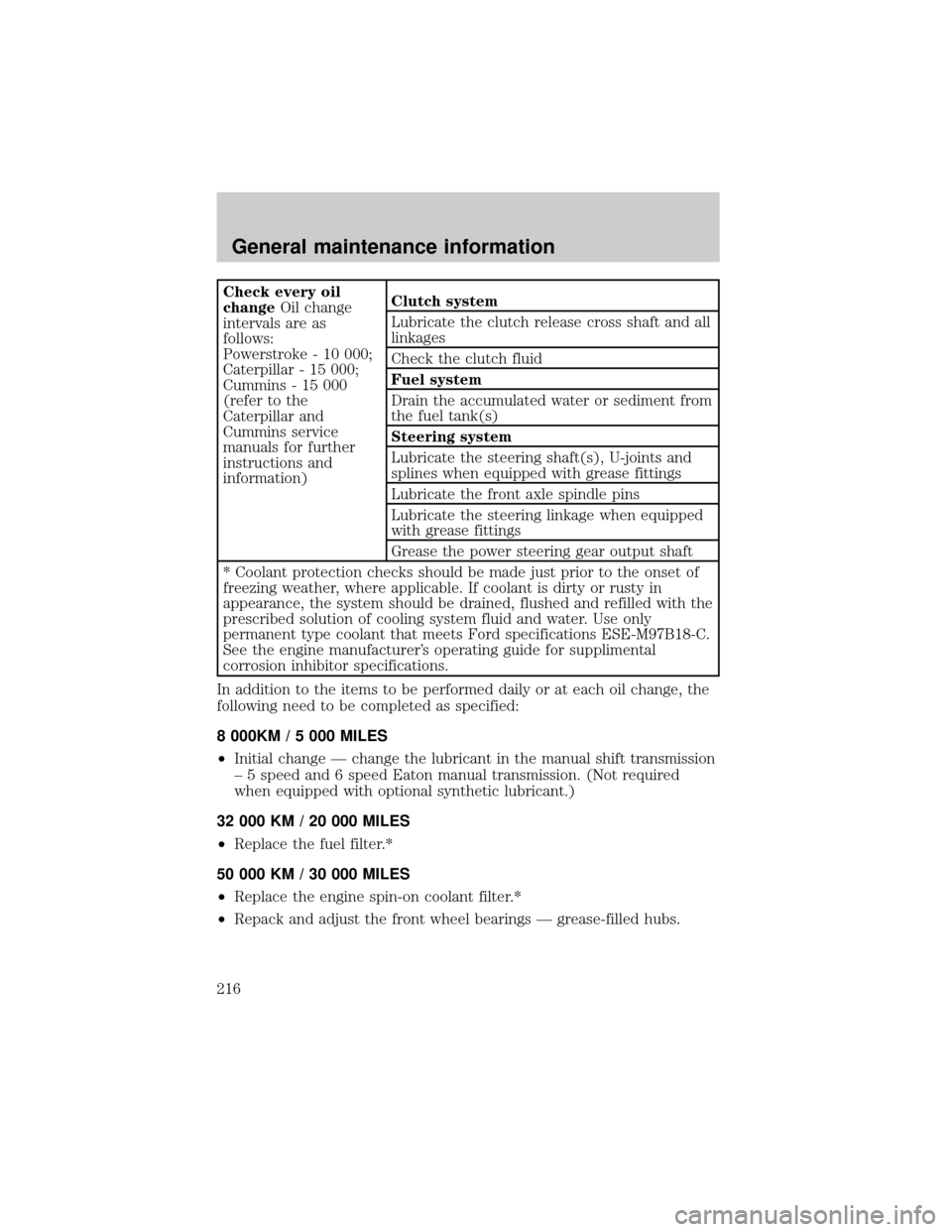
Check every oil
changeOil change
intervals are as
follows:
Powerstroke - 10 000;
Caterpillar - 15 000;
Cummins - 15 000
(refer to the
Caterpillar and
Cummins service
manuals for further
instructions and
information)Clutch system
Lubricate the clutch release cross shaft and all
linkages
Check the clutch fluid
Fuel system
Drain the accumulated water or sediment from
the fuel tank(s)
Steering system
Lubricate the steering shaft(s), U-joints and
splines when equipped with grease fittings
Lubricate the front axle spindle pins
Lubricate the steering linkage when equipped
with grease fittings
Grease the power steering gear output shaft
* Coolant protection checks should be made just prior to the onset of
freezing weather, where applicable. If coolant is dirty or rusty in
appearance, the system should be drained, flushed and refilled with the
prescribed solution of cooling system fluid and water. Use only
permanent type coolant that meets Ford specifications ESE-M97B18-C.
See the engine manufacturer's operating guide for supplimental
corrosion inhibitor specifications.
In addition to the items to be performed daily or at each oil change, the
following need to be completed as specified:
8 000KM / 5 000 MILES
²Initial change Ð change the lubricant in the manual shift transmission
± 5 speed and 6 speed Eaton manual transmission. (Not required
when equipped with optional synthetic lubricant.)
32 000 KM / 20 000 MILES
²Replace the fuel filter.*
50 000 KM / 30 000 MILES
²Replace the engine spin-on coolant filter.*
²Repack and adjust the front wheel bearings Ð grease-filled hubs.
General maintenance information
216